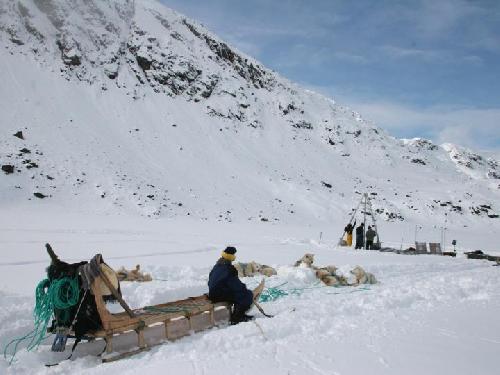Greenland's glaciers are retreating quickly, and a new study shows in historical terms just how quickly: over the past century, at least twice as fast as any other time in the past 9,500 years. The study also provides new evidence for just how sensitive glaciers are to temperature, showing that they responded to past abrupt cooling and warming periods, some of which might have lasted only decades.
To track how glaciers grew and shrank over time, the scientists extracted sediment cores from a glacier-fed lake that provided the first continuous observation of glacier change in southeastern Greenland. They then compared the results to similar rare cores from Iceland and Canada's Baffin Island for a regional view.
"Two things are happening," said study co-author William D'Andrea, a paleoclimatologist at Columbia University's Lamont-Doherty Earth Observatory. "One is you have a very gradual decrease in the amount of sunlight hitting high latitudes in the summer. If that were the only thing happening, we would expect these glaciers to very slowly be creeping forward, forward, forward. But then we come along and start burning fossil fuels and adding carbon dioxide to the atmosphere, and glaciers that would still be growing start to melt back because summer temperatures are warmer."
 To study the advance and retreat of glaciers over nearly 10,000 years, scientists extracted sediment cores from the bottom of glacier-fed Kulusuk Lake in southeast Greenland. Credit: William D'Andrea
To study the advance and retreat of glaciers over nearly 10,000 years, scientists extracted sediment cores from the bottom of glacier-fed Kulusuk Lake in southeast Greenland. Credit: William D'Andrea
Glaciers are dynamic and heavy. As a glacier moves, it grinds the bedrock beneath, creating silt that the glacier's meltwater washes into the lake below. The larger the glacier, the more bedrock it grinds away. Scientists can take sediment cores from the bottom of glacier-fed lakes to see how much silt and organic material settled over time, along with other indicators of a changing climate. They can then use radiocarbon dating to determine when more or less silt was deposited.
Sediment cores from the glacier-fed Kulusuk Lake allowed the scientists to track changes in two nearby glaciers going back 9,500 years. Before the 20th century, the fastest rate of glacier retreat reflected in the core was about 8,500 years ago, at a time when the Earth's position relative to the sun resulted in more summer sunlight in the Arctic.
"If we compare the rate that these glaciers have retreated in the last hundred years to the rate that they retreated when they disappeared between 8,000 and 7,000 years ago, we see the rate of retreat in the last 100 years was about twice what it was under this naturally forced disappearance," D'Andrea said.
The history captured in the Kulusuk Lake cores shows that a warming period started about 8,500 years ago, when the glacier's erosion rates fell rapidly, suggesting the glacier was getting smaller. Then, about 8,200 years ago, temperatures began to cool rapidly and erosion rates increased again. That cooling period has been well documented by other studies and has been connected with large changes in ocean circulation.
Shortly after that advance, around 8,000 years ago, the glaciers wasted away and may have disappeared entirely - little erosion appears in the sediment core between 7,000 and 4,000 years ago, according to the study, appearing in the latest issue of the journal Climate of the Past. During the warm period, the core also shows a large increase in organic matter from plants growing in and around the lake.
When the glaciers began growing again, about 4,000 years ago, they experienced a series of growth pulses that reveal their sensitivity to change. The glaciers expanded in bursts, advancing quickly, retreating briefly, and then expanding farther - until about 100 years ago, according to the study. "This shows that there are internal responses within the climate system that can make glaciers grow and shrink on very short time scales. They're really dynamic systems, which we have not had much evidence for prior to this," D'Andrea said.
The pulses of growth match cooling periods documented in ocean sediment cores and in the continuous cores from Iceland and Baffin Island, suggesting that glaciers have responded in sync across the North Atlantic for at least the past 4,000 years, the authors write.
Understanding how glaciers melt and how ice melted in the past is a critical component to understanding past and future sea level rise and improving risk assessment in the future, said D'Andrea.
source: The Earth Institute at Columbia University